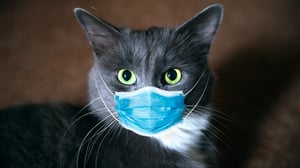‘Spillback’ is when human pathogens mutate and affect other species, and almost a hundred cases have been recorded in the last twenty years. This is revealed by a 'census' carried out by Georgetown University (USA).
The phenomenon is called spillback, and it is the 'opposite' version of the better-known spillover (when pathogens are transferred from wild animals to humans). Spillback, on the contrary, is when viruses, bacteria or parasites are transmitted by humans to animals.
Sometimes it can even be a second passage, i.e. when a micro-organism first transmitted to humans by a wild animal as the result of a series of genetic mutations is then re-transmitted by humans to other species. For example, this 'double leap' has been seen with the SARS-CoV-2 virus that causes Covid. It was probably transferred from bats to humans, then from humans to pets, minks, big cats in zoos and laboratory animals.
Sometimes, however, it is a first infection, i.e. a virus or bacteria that normally infects humans and is then transferred to other species in various ways.
The phenomenon is still relatively little known, but there are several reasons why scientists urgently need to investigate every aspect of it. Above all, we need to bear in mind that animals infected by humans can become a kind of storehouse for the most dangerous pathogens, and subsequently spread them among humans, even when other means like vaccinations or drugs prevent this.
Is the omicron variant a spillback?
However, that's not all. Experts believe it is possible (and in fact often probable) that while a pathogen remains in an animal species infected by humans, it can also mutate and spread more easily. This theory has been suggested to explain the emergence of the omicron variant of the coronavirus, which is very different from previous ones.
In reality there are also other theories linked to the omicron variant that have nothing to do with animals. For example, according to some researchers, the virus has mutated in the bodies of people with compromised immune systems. Others believe the virus mutated in countries where there is no track and trace system, continuing to mutate for months before spreading and being discovered.
Data from the last twenty years has been analysed
In order to better understand what we know about these issues, a group of researchers from Georgetown University (USA) took part in the Viral Emergence Research Initiative (a project sponsored by the US National Science Foundation) and analysed scientific literature over the last two decades. They discovered a surprisingly high rate of spillback: with just under one hundred certified, recorded cases.
There are several routes of transmission, but what emerges from the US study is that in just under one in two cases the transmission occurred in captivity, such as in zoos or vets' offices, where animals are observed closely and where a handler may transmit germs.
Spillback was more likely to occur with primates, probably because these animals have an organism that is closer to ours, and because in many countries they are protected and studied closely to improve conservation.
Studies using Artificial Intelligence
As the science journal Ecological Latters highlights, research now has a tool that can make a difference by helping collect and store data recorded in the most diverse areas of the world, relating to thousands of pathogens in hundreds of animal species, including genetic investigations: A.I.
It is the only way to process millions of elements of such complex systems in a framework that is at least probable, in what is called host-virus network science. If properly handled, the data can help predict spillback and spillover.
For spillbacks, in particular, A.I. makes it possible to understand which animal species are most at risk, based on their genetic code and how their immune system is organised. This in turn makes it (theoretically) possible to plan appropriate countermeasures and careful monitoring to prevent epidemics and pandemics.
What has happened in recent months with SARS-CoV-2, is that we now have hundreds of studies of all kinds. These make up a critical mass of knowledge that is enough to make forecasts. The researchers’ conclusion is that we should aim for something similar for other pathogens, and for animals most at risk.




